
Romford & District and Imperial: DM1-8
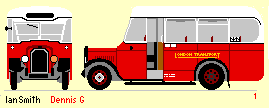 Two companies used Dennis 30-cwt buses in the Romford area in the late 1920s / early 1930s:
Romford & District (Roberts & Hamer), and Imperial (A.E.Blane). These were mostly tiny 14 or 18-seaters,
on a 11ft wheelbase, with a four-cylinder 36 hp engine,
useful for estate development services in the rapidly growing Romford suburbs.
Imperial ran two services: (Marlborough Road - Rainham Cemetery and Collier Row to Hall Lane (later White Hart to Cranham)
Two companies used Dennis 30-cwt buses in the Romford area in the late 1920s / early 1930s:
Romford & District (Roberts & Hamer), and Imperial (A.E.Blane). These were mostly tiny 14 or 18-seaters,
on a 11ft wheelbase, with a four-cylinder 36 hp engine,
useful for estate development services in the rapidly growing Romford suburbs.
Imperial ran two services: (Marlborough Road - Rainham Cemetery and Collier Row to Hall Lane (later White Hart to Cranham)
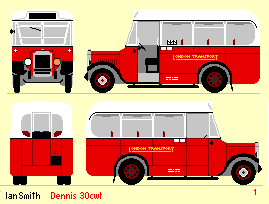 The two companies were taken over by London Transport
in July and November 1934.
The buses were allocated fleetnumber DM1-4 (Romford & District) and DM5-8 (Imperial).
Romford garage (later Hornchurch) was already overcrowded,
so four of the little buses (DM 3,4,5,7) were overhauled and allocated to Barking in January 1935 for use on the Romford G5 services (later 252),
until ousted by Leyland Cubs. The Collier Row to Rainham service 253 was taken over by Romford T-types.
The little Dennises had all gone by the end of 1936.
The two companies were taken over by London Transport
in July and November 1934.
The buses were allocated fleetnumber DM1-4 (Romford & District) and DM5-8 (Imperial).
Romford garage (later Hornchurch) was already overcrowded,
so four of the little buses (DM 3,4,5,7) were overhauled and allocated to Barking in January 1935 for use on the Romford G5 services (later 252),
until ousted by Leyland Cubs. The Collier Row to Rainham service 253 was taken over by Romford T-types.
The little Dennises had all gone by the end of 1936.
DM5 (ex-Imperial) was an odd one out, being a Dennis G based on the 30cwt lorry chassis, with an 18-seater body by Metcalfe.
DM3 and DM4 (ex-Romford) were slightly longer Dennis GLs, with a more powerful 42hp engine, seating 20 and 18 in their Duple bodies.
West Kent Motors, including D202, 203
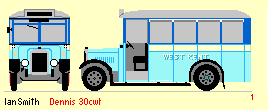 West Kent Motors operated right on the edge of the London Transport area, with some services working over the "border" away from Sevenoaks.
It began at the end of 1927 with a service to Kemsing, via Seal or Otford, worked by a pair of Dennis 30cwts (1 and 2) with 14-seater bodies by Vickers at Crayford.
A second route operated from Sevenoaks to Westerham Hill via Polhill, Halstead and Knockholt.
The direct Sevenoaks - Otford and Riverhead - Polhill sections competed with LT, who were entitled to object.
Agreement was very quickly reached whereby West Kent only operated to Kemsing via Seal, continuing to Otford along the Pilgrims Way, but returning the same way.
They also continued to reach Riverhead via Bat & Ball, but then worked to the foot of Polhill via Chipstead and Chevening Cross.
They could use Polhill, but only for travel, not picking up or setting down passengers between the foot and the top.
West Kent Motors operated right on the edge of the London Transport area, with some services working over the "border" away from Sevenoaks.
It began at the end of 1927 with a service to Kemsing, via Seal or Otford, worked by a pair of Dennis 30cwts (1 and 2) with 14-seater bodies by Vickers at Crayford.
A second route operated from Sevenoaks to Westerham Hill via Polhill, Halstead and Knockholt.
The direct Sevenoaks - Otford and Riverhead - Polhill sections competed with LT, who were entitled to object.
Agreement was very quickly reached whereby West Kent only operated to Kemsing via Seal, continuing to Otford along the Pilgrims Way, but returning the same way.
They also continued to reach Riverhead via Bat & Ball, but then worked to the foot of Polhill via Chipstead and Chevening Cross.
They could use Polhill, but only for travel, not picking up or setting down passengers between the foot and the top.
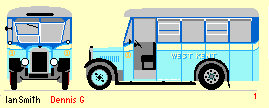 Early in 1928 West Kent acquired three more buses, two of them (3 and 4) Dennis Gs with 20-seater bodies.
These allowed a doubling in frequency to Kemsing to hourly, alternate buses operating via Godden Green to Kemsing and on to Heaverham,
and via Bat & Ball to Kemsing and Otford. Another route was started, to Edenbridge or Brasted, via Ide Hill.
Although West Kent had asked for a route via Cross Keys this was not permitted by Sevenoaks, and the routing was via Bat & Ball,
Riverhead, Bessels Green and Goathurst Common to Ide Hill, then dividing to serve Brasted or Four Elms and Edenbridge.
Early in 1928 West Kent acquired three more buses, two of them (3 and 4) Dennis Gs with 20-seater bodies.
These allowed a doubling in frequency to Kemsing to hourly, alternate buses operating via Godden Green to Kemsing and on to Heaverham,
and via Bat & Ball to Kemsing and Otford. Another route was started, to Edenbridge or Brasted, via Ide Hill.
Although West Kent had asked for a route via Cross Keys this was not permitted by Sevenoaks, and the routing was via Bat & Ball,
Riverhead, Bessels Green and Goathurst Common to Ide Hill, then dividing to serve Brasted or Four Elms and Edenbridge.
New services in late 1928 required more buses, and three DeDion Boutons were bought for these, covering Westerham to Tonbridge via Four Elms,
and Sevenoaks to Plaxtol via Seal and Ivy Hatch. Not all of the services proved profitable, the Tonbridge service proving vulnerable to Medway flooding.
The operating base moved from Bat & Ball to Sundridge Aerodrome in 1929.
In 1932 the company gave up the Plaxtol route to M&D, but started short routes from Sevenoaks to Bayleys Hill via Cross Keys,
and to Fawke Common via Godden Green.
The Dennis G's outlasted the deDions, and took their bodies in late 1932.
Diesel engines also improved their economy.
No3 was rebodied again in 1936 by Stanhays of Tunbridge Wells.
No4 was retired in 1937, and replaced by a 20-seater Ford V8.
A third Dennis 30cwt (no7) was acquired second-hand from Greenhithe & District in February 1933, and was given a diesel engine.
Its Short body was downseated from 18 to 14 to allow it to work along the restricted Pilgrims Way between Kemsing and Otford.
West Kent Motors was not taken over by London Transport in 1934, continuing to provide services to Heaverham, Kemsing, Seal, Chipstead, Fawke Common, Bayley's Hill, Ide Hill, and Edenbridge.
Perhaps it was the complications arising from its services outwith the LPTB area that kept it independent.
At least until the outbreak of war. London Transport took over in October 1939.
LT kept most of the West Kent routes, except where they lay outside its area. It also rationalised them,
not having to avoid competing with itself! So the Ide Hill routes became the 413 and 413A, although the former could not run to Edenbridge,
so turned at Four Elms. These routes also took the more direct route via Bayleys Hill and Cross Keys,
instead of down the little-trafficked road via Bessels Green. The Chipstead traffic was met by tacking the Bat & Ball, Riverhead
and Chipstead section onto the other end of the routes! Residents along the missing Bessels Green to Goathurst Common section complained at theiir deprivation.
The Heaverham service had to operate via Otford,
Seal being forbidden territory (and served anyway by M&D). It became the 421.
The Godden Green and Fawke Common services were taken over by M&D as their 106.
The two surviving Dennis 30cwt buses, Nos 2 & 7, were needed by LT to operate the 421,
until the restriction on larger buses along the Pilgrims Way could be lifted.
They were given LT numbers D202 and D203, hurriedly painted green, and transferred to Dunton Green,
and lasted three months in service, being replaced by Leyland Cubs in January 1940.
Very soon, with wartime traffic, this route was operated by Regals and then STLs.
The surviving Dennis G, No3, was also taken over by LT, but not used and also sold in January 1940.
Gravesend & District Motor Services
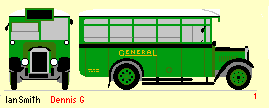 Gravesend & District operated a small fleet running local services in Gravesend.
Their fleet included three Dennis 30cwt and five Dennis G buses. They operated four routes: Gravesend Clocktower to Waterdales;
Gravesend Clocktower to Marquis of Granby; Gravesend Windmill Street to Gloucester Road and Gravesend Windmill Street to Poplar Road.
These routes were taken over by London Transport in October 1933, and the eight small Dennises taken into stock.
After evaluation and a repaint at least some were sent to Addlestone for Weybridge area services and to Amersham to join their sisters there.
Some survived into 1936.
Gravesend & District operated a small fleet running local services in Gravesend.
Their fleet included three Dennis 30cwt and five Dennis G buses. They operated four routes: Gravesend Clocktower to Waterdales;
Gravesend Clocktower to Marquis of Granby; Gravesend Windmill Street to Gloucester Road and Gravesend Windmill Street to Poplar Road.
These routes were taken over by London Transport in October 1933, and the eight small Dennises taken into stock.
After evaluation and a repaint at least some were sent to Addlestone for Weybridge area services and to Amersham to join their sisters there.
Some survived into 1936.
W.Eggleton Ltd, Woking
In the south-west corner of the new LPTB area was Woking, where W.Eggleton operated a service between Woking and Addlestone via Woodham and New Haw,
which became LT 456.
LT took over the company with its five small Dennises, three 18-seater 30cwt and two 20-seater GLs, in June 1934.
The company had also operated a route from Woking to Chobham, outwith the new Board area.
This went to Aldershot & District, together with one Dennis GL.
The four kept by LT were sold in April 1936.
Howes Brown Bus, Englefield Green
This small company operated a railway feeder service between Englefield Green and Egham Station using a Dennis 30cwt and a Dennis G
(as well as a Ford AA).
They were taken over in March 1934 and survived until November 1935.
Amersham & District
Amersham & District had been associated with the General for some time. The company had a large and varied fleet
that included one 30cwt, one G and three GLs. These came under the control of London Transport in November 1933.
The small 30cwt succumbed in 1934, but the other four lasted into 1936.
Edwards Motor Services
This Rainham company used a Dennis GL with 20-seater Thurgood body as one of a pair of buses running between Rainham, the station, and Rainham Ferry.
(The other was a Chevrolet LQ).
LT took over in January 1934, making the route its 393. The Dennis survived until April 1936.
The Reliable
The Reliable Omnibus & Motor Coaches operated an intensive service between Grays and Purfleet,
plus services on the Grays - Alveley route. They had six buses on the routes, two Dennis Gs dating from 1928 (one coach-bodied),
a 14-seater 30cwt (1930) and a GL (also 1930). They also had a pair of 20-seater Commer TKs.
LT took over in May 1934, incorporating their services into the 371 and 372. The Dennis Gs and the 30cwt were sold in 1934, but the GL survived until 1936.

 Ian's Bus Stop
Ian's Bus Stop
 DM main text.
DM main text.
 DM histories
DM histories
 DM photo refs
DM photo refs


 Two companies used Dennis 30-cwt buses in the Romford area in the late 1920s / early 1930s:
Romford & District (Roberts & Hamer), and Imperial (A.E.Blane). These were mostly tiny 14 or 18-seaters,
on a 11ft wheelbase, with a four-cylinder 36 hp engine,
useful for estate development services in the rapidly growing Romford suburbs.
Imperial ran two services: (Marlborough Road - Rainham Cemetery and Collier Row to Hall Lane (later White Hart to Cranham)
Two companies used Dennis 30-cwt buses in the Romford area in the late 1920s / early 1930s:
Romford & District (Roberts & Hamer), and Imperial (A.E.Blane). These were mostly tiny 14 or 18-seaters,
on a 11ft wheelbase, with a four-cylinder 36 hp engine,
useful for estate development services in the rapidly growing Romford suburbs.
Imperial ran two services: (Marlborough Road - Rainham Cemetery and Collier Row to Hall Lane (later White Hart to Cranham)
 The two companies were taken over by London Transport
in July and November 1934.
The buses were allocated fleetnumber DM1-4 (Romford & District) and DM5-8 (Imperial).
Romford garage (later Hornchurch) was already overcrowded,
so four of the little buses (DM 3,4,5,7) were overhauled and allocated to Barking in January 1935 for use on the Romford G5 services (later 252),
until ousted by Leyland Cubs. The Collier Row to Rainham service 253 was taken over by Romford T-types.
The little Dennises had all gone by the end of 1936.
The two companies were taken over by London Transport
in July and November 1934.
The buses were allocated fleetnumber DM1-4 (Romford & District) and DM5-8 (Imperial).
Romford garage (later Hornchurch) was already overcrowded,
so four of the little buses (DM 3,4,5,7) were overhauled and allocated to Barking in January 1935 for use on the Romford G5 services (later 252),
until ousted by Leyland Cubs. The Collier Row to Rainham service 253 was taken over by Romford T-types.
The little Dennises had all gone by the end of 1936.
 West Kent Motors operated right on the edge of the London Transport area, with some services working over the "border" away from Sevenoaks.
It began at the end of 1927 with a service to Kemsing, via Seal or Otford, worked by a pair of Dennis 30cwts (1 and 2) with 14-seater bodies by Vickers at Crayford.
A second route operated from Sevenoaks to Westerham Hill via Polhill, Halstead and Knockholt.
The direct Sevenoaks - Otford and Riverhead - Polhill sections competed with LT, who were entitled to object.
Agreement was very quickly reached whereby West Kent only operated to Kemsing via Seal, continuing to Otford along the Pilgrims Way, but returning the same way.
They also continued to reach Riverhead via Bat & Ball, but then worked to the foot of Polhill via Chipstead and Chevening Cross.
They could use Polhill, but only for travel, not picking up or setting down passengers between the foot and the top.
West Kent Motors operated right on the edge of the London Transport area, with some services working over the "border" away from Sevenoaks.
It began at the end of 1927 with a service to Kemsing, via Seal or Otford, worked by a pair of Dennis 30cwts (1 and 2) with 14-seater bodies by Vickers at Crayford.
A second route operated from Sevenoaks to Westerham Hill via Polhill, Halstead and Knockholt.
The direct Sevenoaks - Otford and Riverhead - Polhill sections competed with LT, who were entitled to object.
Agreement was very quickly reached whereby West Kent only operated to Kemsing via Seal, continuing to Otford along the Pilgrims Way, but returning the same way.
They also continued to reach Riverhead via Bat & Ball, but then worked to the foot of Polhill via Chipstead and Chevening Cross.
They could use Polhill, but only for travel, not picking up or setting down passengers between the foot and the top.
 Early in 1928 West Kent acquired three more buses, two of them (3 and 4) Dennis Gs with 20-seater bodies.
These allowed a doubling in frequency to Kemsing to hourly, alternate buses operating via Godden Green to Kemsing and on to Heaverham,
and via Bat & Ball to Kemsing and Otford. Another route was started, to Edenbridge or Brasted, via Ide Hill.
Although West Kent had asked for a route via Cross Keys this was not permitted by Sevenoaks, and the routing was via Bat & Ball,
Riverhead, Bessels Green and Goathurst Common to Ide Hill, then dividing to serve Brasted or Four Elms and Edenbridge.
Early in 1928 West Kent acquired three more buses, two of them (3 and 4) Dennis Gs with 20-seater bodies.
These allowed a doubling in frequency to Kemsing to hourly, alternate buses operating via Godden Green to Kemsing and on to Heaverham,
and via Bat & Ball to Kemsing and Otford. Another route was started, to Edenbridge or Brasted, via Ide Hill.
Although West Kent had asked for a route via Cross Keys this was not permitted by Sevenoaks, and the routing was via Bat & Ball,
Riverhead, Bessels Green and Goathurst Common to Ide Hill, then dividing to serve Brasted or Four Elms and Edenbridge.
 Gravesend & District operated a small fleet running local services in Gravesend.
Their fleet included three Dennis 30cwt and five Dennis G buses. They operated four routes: Gravesend Clocktower to Waterdales;
Gravesend Clocktower to Marquis of Granby; Gravesend Windmill Street to Gloucester Road and Gravesend Windmill Street to Poplar Road.
These routes were taken over by London Transport in October 1933, and the eight small Dennises taken into stock.
After evaluation and a repaint at least some were sent to Addlestone for Weybridge area services and to Amersham to join their sisters there.
Some survived into 1936.
Gravesend & District operated a small fleet running local services in Gravesend.
Their fleet included three Dennis 30cwt and five Dennis G buses. They operated four routes: Gravesend Clocktower to Waterdales;
Gravesend Clocktower to Marquis of Granby; Gravesend Windmill Street to Gloucester Road and Gravesend Windmill Street to Poplar Road.
These routes were taken over by London Transport in October 1933, and the eight small Dennises taken into stock.
After evaluation and a repaint at least some were sent to Addlestone for Weybridge area services and to Amersham to join their sisters there.
Some survived into 1936.
 Ian's Bus Stop
Ian's Bus Stop DM main text.
DM main text. DM histories
DM histories